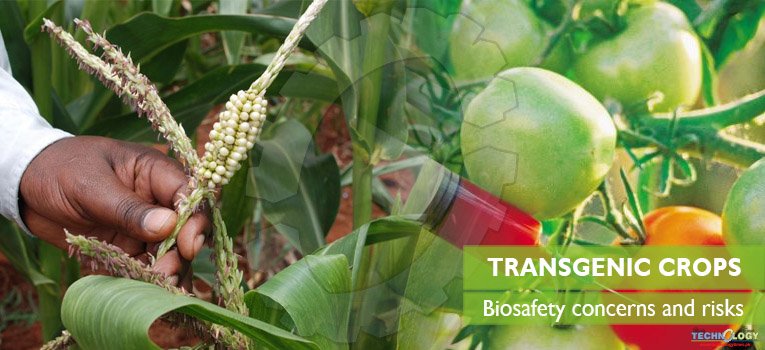Transgenic crops are rapidly growing in the developing world but some developing countries rising them in significant quantities. Transgenic crops offer immense benefits in terms of increased yield, better quality and enhanced resistance to biotic and abiotic factors. But, many biosafety concerns and public issues stay connected. It is essential for systematic investigation about the fate of transgenic crops in the environment and their contact with wild relatives and non-target organisms. The development and release of transgenic crops must be based on sound scientific reasoning and experience. The regulatory requirement for production of transgenic crops must be reorganized and consistent to obtain sustainable food production, poverty reduction and environmental protection.

The genetically engineered crops have various biosafety concerns and potential risks related to human health, and environment.
Spreading of GMO in the environment
The risks include genetic contamination of other crops, transfer of toxin/allergen from one life to another and evolution of new toxins/allergens and impact on soil fertility. Also, inappropriate release of dangerous chemicals or pathogens used in the experiment may be a threat.
Horizontal and vertical gene transfer
Vertical gene transfers or outcrossing is the transgenes transfer from GM crops to other related weeds or crops. This transgene transfer to other related species entirely depends on the GM crops. In Europe, there are no indigenous related weeds of maize and potato that receive transgenes through pollens. But, oilseeds have various related species.
The outcrossing depends upon various factors like climatic conditions, pollens viability, agriculture practices, and outcrossing partner’s availability. In horizontal gene transfer, the transfer occurs from GM crops to microorganisms.
Microorganisms especially bacteria have the ability to take up DNA from other organisms or from the environment and to integrate the DNA into their genome. In case of Horizontal gene transfer (HGT), the gene can escape into the environment without any control.
Potential effect of transgenic crops on human health
The food that derived from genetically modified crops may have negative effects on human health. They must be tested for allergenicity, toxic effects, and unfavorable changes in nutrient composition. Unintended or unexpected changes in nutrient composition can result from plant breeding method.
Potential trait specific environmental effects
The traits that mainly related to transgenic crops are herbicide tolerance and insect, pest resistance. The herbicide tolerance genes provide tolerance to different herbicides such as glufosinate (BASTA) or glyphosate (Round-Up). These are environment friendly than other herbicides and cause less pollution of groundwater and soil.
The possibility of a later application during cultivation could lead to a better soil coverage with weeds and less erosion. On the other hand, the permanent application of herbicides may reduce the weeds biodiversity and related animals considerably.
The insect resistant GM crops express the BT toxin. The BT producing weeds resulted due to outcrossing of BT crops that is a negative effect. This lead to the death of Monarch butterfly.
In case of the negative effect of GM crops on soil fertility, the main concern is about the seepage of different compounds (as many plant leak chemical compounds in the soil through their roots) than the normal crops; as an unintended consequence of their altered DNA. It is assumed that in that scenario, this harmful chemical can disturb the growth of micro-organism communities living near the transgenic plant.
The BT toxin that exuded into the soil via plant roots, may interact with the soil organism and cause a negative effect on the soil ecosystem. The development of resistance in pest against the toxin is an important issue. So refuge crop strategy may be used, where non-BT plants are grown to delay the development of resistance.
Risks related to antibiotic-resistant gene
Antibiotic-resistance genes are selectable markers of plant transformation . The result in the formation of antibiotic-resistant human pathogens. Using this this marker gene will result in the formation of antibiotic-resistant human pathogens transferring it to the environment .
However, the mechanism of transfer of the genes from GM crop to bacteria are itself open to discussion and it has not been experimentally shown. Apart from this, the antibiotics that normally used in the growth of transgenic crops are not the ones which are regularly used in the treatment of human diseases.
In spite of the suspicious status of any harm confer by this marker gene, plant biotechnologists are now using techniques to produce ‘marker-free plants’. ‘Clean gene technology’ is also refer as ‘marker-free plants’.
Ethical concerns
Numerous ethical issues related with Horizontal gene transfer from GMOs have been elevated including supposed threats to the veracity and intrinsic significance of the organisms included, to the idea of natural order and integrity of species, and to the integrity of the ecosystems in which the GMOs occurs (Gene technology ethics committee, 2006).
Ways to manage risks
Regulatory consents for field measures of GMOs frequently require trials to limit and switch the release in space and time.
A horizontal gene transfer produces new GMO due to the presented gene(s) of additional species .
Unique license or permit not organised by the management processes of this new GMO will rise to adversarial effects . The avoiding transgenic crops contamination , through these:
- Establishment of male sterility to overcome the problem of pollen outcross
- Use of tissue-specific or inducible promoter to stop adverse effects on the growth and development of the plant and environment
- Use of chloroplast by maternally inherited to overcome the pollen-mediated gene flow
- Developing plant good manufacturing practices and waste product disposal approach
- Use of markerless or clean gene technology
- Use of refuge crop strategy
Conclusion
We concluded that interaction of its ecological function and natural history with the agroecosystem and ecosystems creates a specific impact on GM crop.
The benefits of some GM crops in the agricultural systems appears to balance their relatively low risk, but others seem more dangerous.
Furthermore, this debate should check the intention that GM crops are the best mean of agricultural strengthening compared to other agricultural technologies.